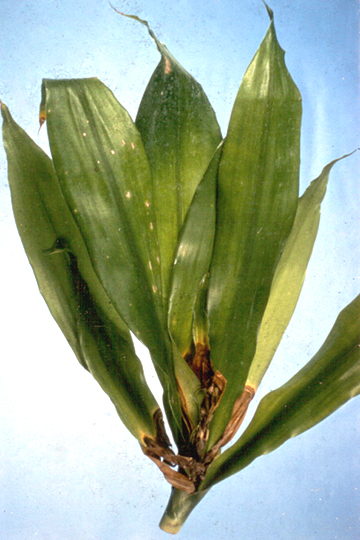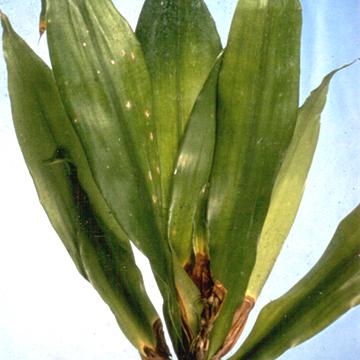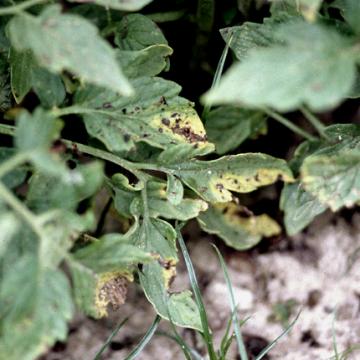DISEASE: Bacterial rot
HOST: Dahlia
Longitudinal section of dahlia with discolored, rotted tissues.

Bacterial rot | Dahlia
DISEASE: Bacterial rot
HOST: Dahlia (Dahlia sp.)
PATHOGEN: Dickeya sp.
PATHOGEN SYNONYM: Erwinia chrysanthemi
SOURCE: J. Young
DISEASE: Bacterial rot
HOST: Dracaena
Rot at base of leaves.

Bacterial rot | Dracaena
DISEASE: Bacterial rot
HOST: Dracaena (Dracaena deremensis)
PATHOGEN: Dickeya sp.
PATHOGEN SYNONYM: Erwinia chrysanthemi
SOURCE: A. Alvarez
DISEASE: Bacterial rot
HOST: Dracaena
Systemic rot throughout central stems.

Bacterial rot | Dracaena
DISEASE: Bacterial rot
HOST: Dracaena (Dracaena deremensis)
PATHOGEN: Dickeya sp.
PATHOGEN SYNONYM: Erwinia chrysanthemi
SOURCE: A. Chase
DISEASE: Bacterial rot
HOST: Fennel
Soft rot of fennel.

Bacterial rot | Fennel
DISEASE: Bacterial rot
HOST: Fennel (Foeniculum vulgare)
PATHOGEN: Dickeya sp.
PATHOGEN SYNONYM: Erwinia chrysanthemi
SOURCE: R. Davis
DISEASE: Olive knot
HOST: Olive
Multiple infections of young stems. The bacterium invades vascular tissues during certain times of the year and may be isolated from branches that appear healthy.

Olive knot | Olive
DISEASE: Olive knot
HOST: Olive (Olea europaea)
PATHOGEN: Pseudomonas savastanoi pv. savastanoi
SOURCE: M. Schroth
DISEASE: Olive knot
HOST: Olive
Tree with knots/galls on branches along with twig dieback, which is associated with knots. Fusarium and Diplodia spp. infect through knots and are thought to be main reason for dieback.

Olive knot | Olive
DISEASE: Olive knot
HOST: Olive (Olea europaea)
PATHOGEN: Pseudomonas savastanoi pv. savastanoi
SOURCE: M. Schroth
DISEASE: Olive knot
HOST: Olive
Multiple infections on olive branch. Knots at this stage begin to die from the outside in and are infected by several fungi.

Olive knot | Olive
DISEASE: Olive knot
HOST: Olive (Olea europaea)
PATHOGEN: Pseudomonas savastanoi pv. savastanoi
SOURCE: M. Schroth
DISEASE: Syringae leaf spot
HOST: Tomato
Leaves with brown necrotic lesions and chlorotic margins. Symptoms vary greatly among cultivars. Some have black or brown lesions with bright yellow, chlorotic areas and others do not have yellowing.

Syringae leaf spot | Tomato
DISEASE: Syringae leaf spot
HOST: Tomato (Lycopersicon esculentum)
PATHOGEN: Pseudomonas syringae pv. syringae
SOURCE: R. Gitaitis









